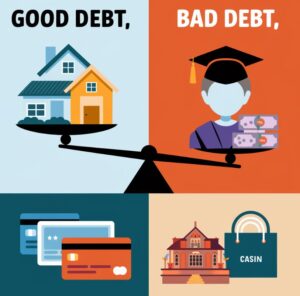For decades, the concepts of “good debt” and “bad debt” have guided personal financial advice and public policy debates. The premise is simple: Good debt is borrowing that generates future benefits, like financing an education or infrastructure, while bad debt is borrowing for indulgences or expenses without lasting returns. But in reality, this framework oversimplifies a complex issue. The real distinction isn’t between good and bad debt but between good and bad risk management. As the U.S. faces rising public debt—nearing $36 trillion—understanding this concept is crucial.
Reevaluating Good vs. Bad Debt
The distinction between good and bad debt is rooted in potential outcomes. For example, using a $200,000 loan to buy Bitcoin in 2010 might have turned into a staggering $218 billion by now, while using the same loan to attend MIT could lead to an extra $1.5 million in lifetime earnings. Superficially, the Bitcoin investment seems “better,” but this analysis ignores the critical factor of risk.
An MIT degree offers predictable, low-risk returns, supported by fixed-rate loans and government forgiveness programs. Bitcoin, by contrast, is speculative and highly volatile. Borrowing for education demonstrates good risk management; betting on Bitcoin is more akin to gambling.
The lesson here? Debt’s value depends less on its purpose and more on how risks are managed.
Risk Management in Government Borrowing
Risk management applies to public spending as well. Political parties frame debt differently:
- Democrats often advocate for borrowing to fund growth-boosting projects, such as highways or semiconductor factories.
- Republicans prioritize tax cuts to stimulate private sector growth.
Both strategies aim to ensure the economy’s growth rate (g) exceeds the real interest rate (r). But the challenge lies in the unpredictability of g and r over time.
In the 2010s, low interest rates led some economists to recommend aggressive government borrowing. While rates were low, the logic of g > r seemed sound. Yet as rates rose, this approach exposed vulnerabilities, highlighting why debt strategies must account for changing conditions.
Good Risk Management: A Better Framework
Effective risk management involves borrowing for projects likely to deliver positive returns while controlling the costs of that debt. For governments, this means:
- Selecting high-value investments: Public spending varies widely in effectiveness. While infrastructure projects like highways may yield $5 for every dollar spent, wasteful initiatives can return as little as $0.05.
- Ensuring efficient execution: Regulatory hurdles and political compromises often inflate costs and delay benefits, as seen with the Infrastructure Investment and Jobs Act.
- Structuring debt wisely: Short-term borrowing can minimize immediate costs but exposes borrowers to future rate hikes. Conversely, long-term debt locks in current rates but at potentially higher initial costs. The U.S. government missed opportunities to secure low rates during the 2010s by not issuing more long-term debt.

The Pitfalls of Poor Risk Management
Debt without proper management can lead to long-term problems:
- Projects with high initial returns may falter over time, leaving debts unpaid.
- Mismanagement of tax cuts, such as structuring breaks inefficiently, can undermine potential economic benefits.
- Inflation from excessive government debt can drive up borrowing costs and erode economic stability.
The Case for Smarter Public Spending
Government debt, unlike household debt, has unique risks and opportunities. Printing money to pay bills may seem like an advantage, but it can also fuel inflation. To manage these risks:
- Focus on productivity-enhancing investments.
- Avoid unnecessary spending that competes with more valuable projects.
- Prioritize efficiency in execution to ensure taxpayer dollars generate meaningful returns.
Conclusion: Focus on Risk, Not Labels
The debate over good and bad debt misses the mark. Instead, policymakers and individuals alike should prioritize risk management. By selecting high-value investments, managing debt costs, and planning for an uncertain future, the U.S. can navigate its growing debt responsibly. As public debt continues to rise, the question isn’t whether to borrow but how to do so wisely.
Read More: Russia-Ukraine War after 1,000+ Days: Intense Clashes, Missile Strikes, and Global Reactions
[…] Read More: Good Debt vs. Bad Debt: Debunking the Myth and What You Need to Know […]